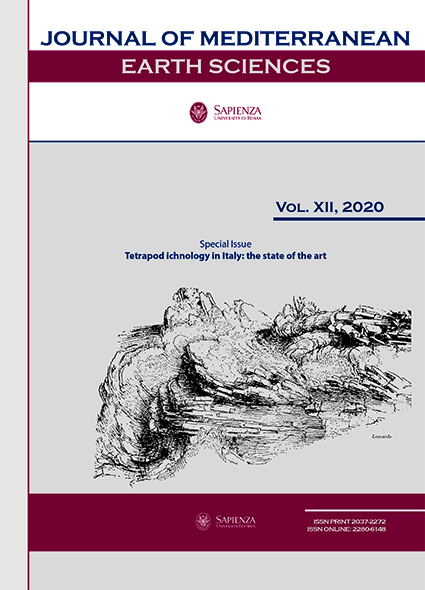Cretaceous tetrapod tracks from Italy: a treasure trove of exceptional biodiversity
DOI:
https://doi.org/10.3304/jmes.2020.16873Keywords:
Palaeontology, Ichnology, SedimentologyAbstract
After about thirty years of investigations, the Cretaceous tetrapod track record from Italy has proved to be a ‘Rosetta Stone’ for improving our understanding of the palaeogeographical and palaeoenvironmental evolution of the peri-Adriatic area. In the present contribution, we summarize the current knowledge and the different interpretations proposed on the basis of twelve ichnosites from northern, central and southern Italy to date discussed within the scientific community. The tetrapod track record is represented by few ichnosites in the earliest Cretaceous, whereas the bulk of the record has been reported from carbonate platform deposits of the Aptian-Cenomanian interval and, in the Late Cretaceous, from a mega-tracksite in Apulia preserving thousands of dinosaur footprints. On the whole, the ichnological diversity documented by the material indicates a high diversity of producers, among which are sauropods, different theropods, ankylosaurs and hadrosaurs. The persistent occurrence of dinosaur footprints at different stratigraphic levels produced significant questions and constituted a dramatic constraint for the understanding of the palaeogeographical and geodynamical evolution of the Mediterranean area during the Mesozoic,Downloads
Published
2020-09-22
How to Cite
Petti, F. M., Antonelli, M., Citton, P., Mariotti, N., Petruzzelli, M., Pignatti, J., D'Orazi Porchetti, S., Romano, M., Sacchi, E., Sacco, E., & Wagensommer, A. (2020). Cretaceous tetrapod tracks from Italy: a treasure trove of exceptional biodiversity. Journal of Mediterranean Earth Sciences, 12. https://doi.org/10.3304/jmes.2020.16873
Issue
Section
Tetrapod ichnology in Italy: the state of the art
License
The submission has not been previously published, nor is it before another journal for consideration (or an explanation has been provided in Comments to the Editor).


